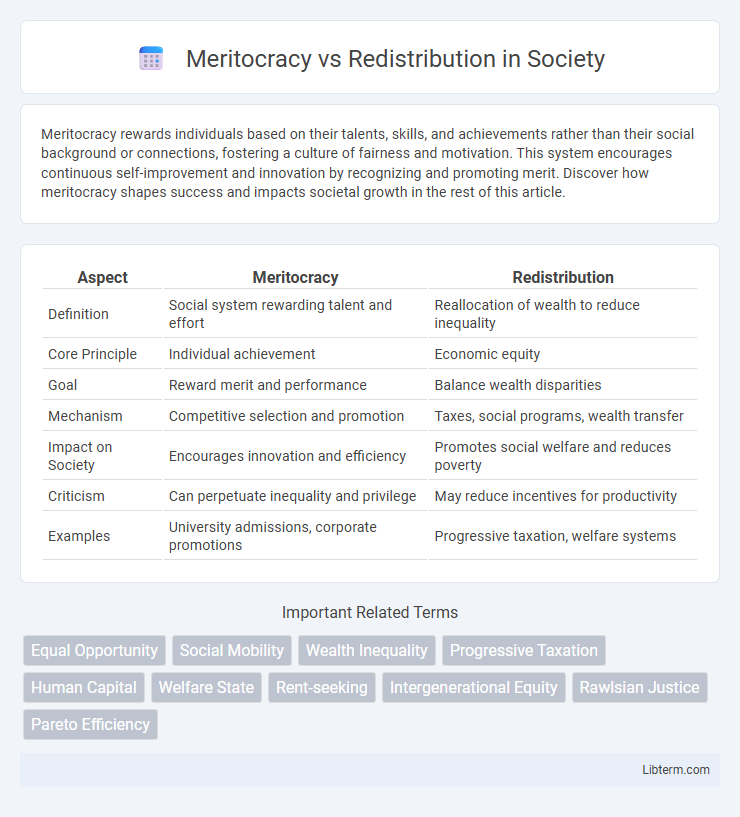Meritocracy rewards individuals based on their talents, skills, and achievements rather than their social background or connections, fostering a culture of fairness and motivation. This system encourages continuous self-improvement and innovation by recognizing and promoting merit. Discover how meritocracy shapes success and impacts societal growth in the rest of this article.
Table of Comparison
| Aspect | Meritocracy | Redistribution |
|---|---|---|
| Definition | Social system rewarding talent and effort | Reallocation of wealth to reduce inequality |
| Core Principle | Individual achievement | Economic equity |
| Goal | Reward merit and performance | Balance wealth disparities |
| Mechanism | Competitive selection and promotion | Taxes, social programs, wealth transfer |
| Impact on Society | Encourages innovation and efficiency | Promotes social welfare and reduces poverty |
| Criticism | Can perpetuate inequality and privilege | May reduce incentives for productivity |
| Examples | University admissions, corporate promotions | Progressive taxation, welfare systems |
Understanding Meritocracy: Principles and Practice
Meritocracy is a socio-economic system where individuals' success is determined by talent, effort, and achievement rather than wealth or social status. It emphasizes equal opportunities, rewarding merit with advancement in education, careers, and leadership roles to promote efficiency and innovation. Critics argue meritocracy can perpetuate inequality by overlooking structural barriers that hinder access to opportunities for disadvantaged groups.
The Philosophy Behind Redistribution
The philosophy behind redistribution centers on promoting social equity and reducing economic disparities through government intervention, often via taxation and welfare policies, to ensure a fair allocation of resources. It challenges pure meritocracy by acknowledging systemic barriers that prevent equal opportunities, arguing that wealth and privilege are not solely the result of individual effort. Redistribution aims to create a more balanced society by addressing structural inequalities and providing support to disadvantaged groups.
Historical Roots of Meritocracy and Redistribution
Meritocracy traces its historical roots to Ancient China's imperial examination system and the Enlightenment era's emphasis on reason and individual achievement, promoting social mobility through talent and effort. Redistribution, however, stems from early communal societies and the rise of socialist ideologies in the 19th century, aiming to reduce economic inequality by reallocating wealth. These contrasting origins reflect fundamentally different beliefs about justice, fairness, and the organization of society.
Economic Impacts: Growth, Innovation, and Equity
Meritocracy drives economic growth by incentivizing innovation and rewarding individual talent, leading to higher productivity and technological advancements. Redistribution aims to promote equity by reducing income inequality, which can enhance social stability and increase overall consumer demand by boosting the purchasing power of lower-income households. Balancing meritocratic incentives with targeted redistribution policies supports sustainable growth while addressing economic disparities.
Social Mobility: Opportunities and Barriers
Meritocracy promotes social mobility by rewarding individual talent and effort, creating opportunities for success based on merit rather than background. Redistribution aims to reduce barriers by reallocating resources to level the playing field, addressing systemic inequalities that hinder upward mobility. Both approaches impact social mobility differently, with meritocracy emphasizing personal achievement and redistribution focusing on structural support.
Criticisms of Meritocracy: Myths and Realities
Criticisms of meritocracy highlight myths such as the belief that equal opportunity exists uniformly, ignoring systemic inequalities that skew access to education and employment. The reality reveals that meritocratic systems often reinforce existing social hierarchies by rewarding inherited advantages rather than pure talent or effort. Studies show that meritocracy can perpetuate economic disparities, challenging the assumption that it alone promotes fairness and social mobility.
Redistribution: Tools, Policies, and Outcomes
Redistribution employs tools like progressive taxation, social welfare programs, and universal basic income to reduce economic inequality and provide a social safety net. Policies such as targeted subsidies, minimum wage laws, and public healthcare aim to enhance access to resources and improve living standards for disadvantaged groups. Outcomes often include decreased poverty rates, improved social mobility, and more equitable opportunities across socioeconomic classes.
Balancing Fairness and Efficiency
Meritocracy emphasizes allocating resources and opportunities based on individual talent and effort, promoting efficiency by rewarding productivity and innovation. Redistribution aims to reduce economic inequality through policies like progressive taxation and social welfare, enhancing fairness by ensuring basic needs and equal opportunities. Balancing these approaches requires designing systems that incentivize achievement while providing support to marginalized groups, fostering both economic growth and social equity.
Global Perspectives: Success Stories and Failures
Meritocracy, promoting individual achievement based on talent and effort, has driven economic growth in countries like Singapore and South Korea, where education and skill development align with market demands. Conversely, redistribution policies in Nordic countries such as Sweden and Denmark have reduced inequality and maintained high living standards through progressive taxation and comprehensive social welfare systems. Failures arise when meritocracy entrenches social inequality, as seen in some developing nations, or when redistribution stifles economic incentives, leading to inefficiency and slower growth.
The Future of Meritocracy and Redistribution
The future of meritocracy hinges on balancing individual talent recognition with equitable resource distribution to address systemic inequalities. Emerging models emphasize adaptive redistribution policies that complement merit-based rewards, ensuring social mobility and reducing economic disparities. Technological advancements and data-driven governance are poised to enhance transparency and fairness in allocating opportunities and wealth.
Meritocracy Infographic

 libterm.com
libterm.com